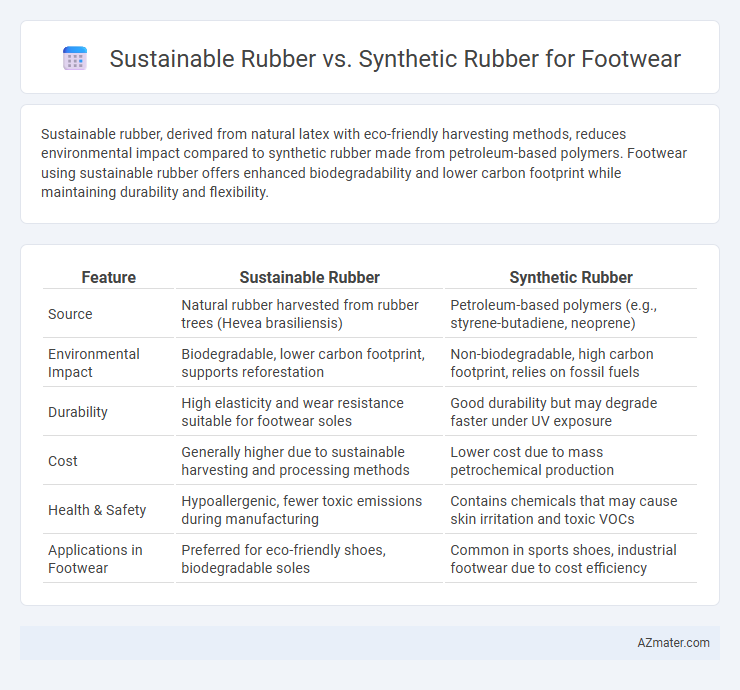Sustainable rubber, derived from natural latex with eco-friendly harvesting methods, reduces environmental impact compared to synthetic rubber made from petroleum-based polymers. Footwear using sustainable rubber offers enhanced biodegradability and lower carbon footprint while maintaining durability and flexibility.
Table of Comparison
| Feature | Sustainable Rubber | Synthetic Rubber |
|---|---|---|
| Source | Natural rubber harvested from rubber trees (Hevea brasiliensis) | Petroleum-based polymers (e.g., styrene-butadiene, neoprene) |
| Environmental Impact | Biodegradable, lower carbon footprint, supports reforestation | Non-biodegradable, high carbon footprint, relies on fossil fuels |
| Durability | High elasticity and wear resistance suitable for footwear soles | Good durability but may degrade faster under UV exposure |
| Cost | Generally higher due to sustainable harvesting and processing methods | Lower cost due to mass petrochemical production |
| Health & Safety | Hypoallergenic, fewer toxic emissions during manufacturing | Contains chemicals that may cause skin irritation and toxic VOCs |
| Applications in Footwear | Preferred for eco-friendly shoes, biodegradable soles | Common in sports shoes, industrial footwear due to cost efficiency |
Introduction to Rubber Types in Footwear
Sustainable rubber in footwear is derived from natural sources such as Hevea brasiliensis trees, offering biodegradability and lower environmental impact compared to synthetic rubber, which is petroleum-based and less eco-friendly. Natural rubber provides excellent elasticity, durability, and comfort, making it ideal for footwear applications that demand flexibility and resilience. Synthetic rubber, including types like styrene-butadiene (SBR) and neoprene, is engineered for specific performance characteristics such as abrasion resistance and water impermeability, but its production involves higher carbon emissions and non-renewable resources.
What is Sustainable Rubber?
Sustainable rubber is natural latex harvested from rubber trees using eco-friendly methods that preserve biodiversity and support community livelihoods, contrasting synthetic rubber derived from petroleum-based chemicals. This type of rubber reduces environmental impact by promoting responsible land use, minimizing carbon emissions, and avoiding toxic byproducts common in synthetic rubber production. Sustainable rubber offers a renewable, biodegradable alternative ideal for eco-conscious footwear manufacturing, enhancing product durability and comfort while aligning with green supply chain practices.
Overview of Synthetic Rubber
Synthetic rubber, primarily derived from petroleum-based monomers such as styrene and butadiene, offers consistent performance characteristics and cost-effective production for footwear applications. Its durability, flexibility, and resistance to abrasion and chemicals make it a popular choice for athletic and casual shoes, despite environmental concerns linked to fossil fuel extraction and non-biodegradability. Innovations in bio-based synthetic rubbers aim to reduce the ecological footprint by incorporating renewable resources and enhancing recyclability without compromising material properties.
Environmental Impact: Sustainable vs Synthetic Rubber
Sustainable rubber, derived from natural latex harvested from rubber trees, significantly reduces environmental impact by promoting biodiversity, carbon sequestration, and reduced chemical usage compared to synthetic rubber made from petroleum-based polymers. The biodegradability of sustainable rubber minimizes landfill waste and microplastic pollution, while synthetic rubber production involves high energy consumption and generates greenhouse gases. Choosing sustainable rubber in footwear manufacturing supports a circular economy and lowers the overall carbon footprint of shoe production.
Performance and Durability in Footwear
Sustainable rubber, derived from natural sources such as Hevea brasiliensis, offers superior breathability, flexibility, and biodegradability compared to synthetic rubber, making it an eco-friendly choice for footwear. Synthetic rubber, typically made from petrochemical compounds like styrene-butadiene, provides enhanced abrasion resistance and consistent performance under extreme temperatures, ideal for high-heavy-duty footwear applications. While sustainable rubber excels in comfort and environmental impact, synthetic rubber remains preferable for longevity and resistance in rugged footwear environments.
Cost Comparison and Market Trends
Sustainable rubber, derived from natural and renewable sources, often incurs higher production costs compared to synthetic rubber made from petrochemicals, impacting footwear pricing. Market trends reveal a growing consumer preference for eco-friendly footwear materials, driving demand for sustainable rubber despite its premium cost. Advancements in sustainable rubber processing and increasing environmental regulations are expected to narrow the cost gap, boosting its market share in the footwear industry.
Comfort and Wearability Factors
Sustainable rubber used in footwear offers enhanced breathability and flexibility, contributing to superior comfort during extended wear compared to traditional synthetic rubber. Natural rubber's elasticity adapts better to foot movement, reducing fatigue and increasing overall wearability, while synthetic rubber often provides durability but can compromise softness and cushioning. Advances in bio-based synthetic rubbers aim to combine sustainability with improved comfort, balancing environmental impact and consumer needs for long-lasting, comfortable footwear.
Ethical and Social Considerations
Sustainable rubber for footwear promotes environmental responsibility by supporting fair labor practices and reducing deforestation impact, enhancing ethical sourcing transparency. Synthetic rubber, derived from petroleum, raises concerns about fossil fuel dependency and often lacks social accountability in production regions. Choosing sustainable rubber aligns with social equity goals, ensuring safe working conditions and community well-being in the rubber supply chain.
Consumer Preferences and Industry Response
Consumer preferences increasingly favor sustainable rubber in footwear due to environmental concerns and demand for eco-friendly products, driving brands to integrate natural rubber derived from rubber trees and recycled materials. The footwear industry responds by innovating with biodegradable and sustainably sourced rubber alternatives, reducing reliance on petroleum-based synthetic rubber, which has a larger carbon footprint and environmental impact. Market analysis shows a growing segment of eco-conscious consumers willing to pay a premium for sustainable options, prompting major companies to expand their sustainable footwear lines and improve transparency in material sourcing.
Future Outlook: Advancements in Rubber for Footwear
Emerging technologies in sustainable rubber production, such as bio-based polymers and enhanced rubber tree cultivation methods, are poised to reduce environmental impact while maintaining durability and flexibility essential for footwear. Innovations in synthetic rubber, including the development of recyclable and biodegradable variants, aim to address traditional environmental concerns without compromising performance. The convergence of sustainable practices and advanced material science is expected to drive the footwear industry towards more eco-friendly, high-performance rubber solutions.

Infographic: Sustainable rubber vs Synthetic rubber for Footwear
 azmater.com
azmater.com